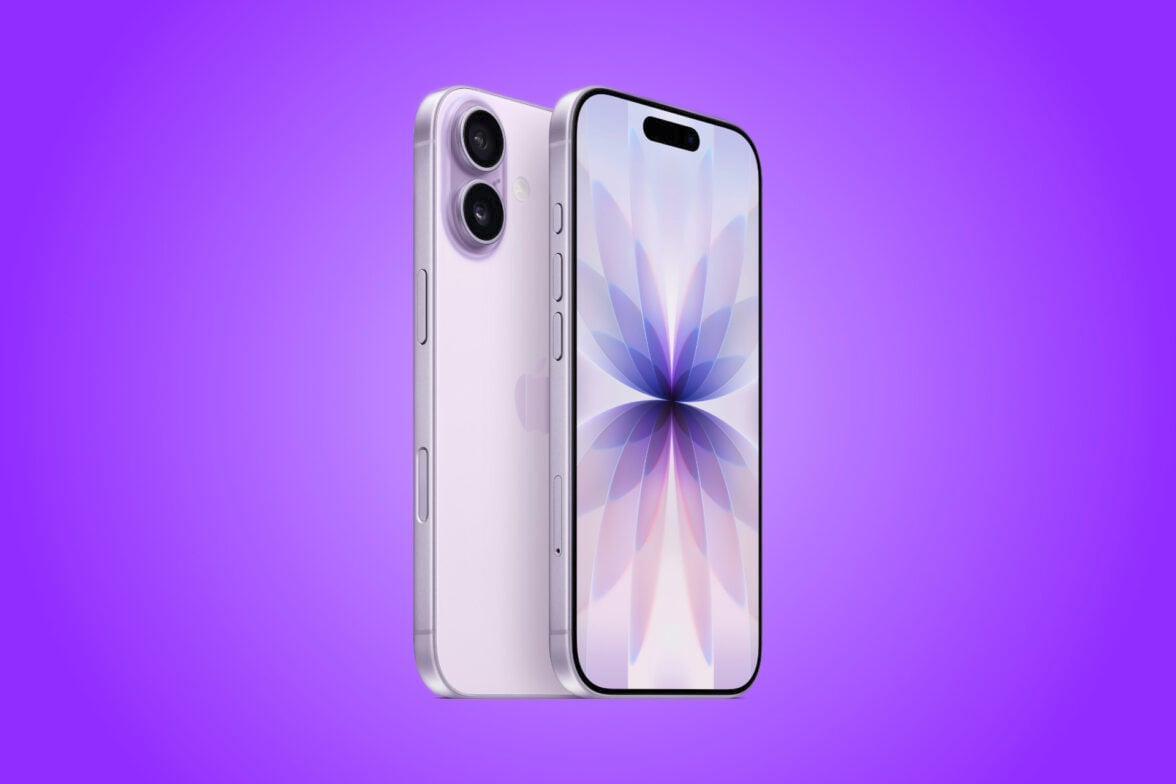Inheriting even more features from the Pro range, the new base model Apple iPhone 17 is far from standard.
Gadget makers have always loved the concept of Pro models, reserving a few premium features for the more expensive option in the hope that you’ll hand over more cash. Of course, the trick is to get the feature mix just right – encouraging some people to go Pro without driving away those who can only afford the base model.
Apple’s first Pro-model phones arrived back in 2019 with the iPhone 11 Pro and iPhone 11 Pro Max. The standout Pro feature has always been the triple-lens rear camera array featuring a telephoto lens, which is still the case with this year’s iPhone 17 range.
This aside, a surprising number of Pro features have trickled down to the new standard iPhone 17 model, all while retaining the $1,399 price tag. In comparison, the iPhone 17 Pro starts at $1999.
Table of contents
- First impressions
- Specifications and price
- Features
- Photography features
- Who is the Apple iPhone 17 for?
Apple iPhone 17 first impressions
At first glance, the Apple iPhone 17 looks practically identical to the iPhone 16/17 Pro models, apart from the expected lack of a third telephoto camera lens at the rear.
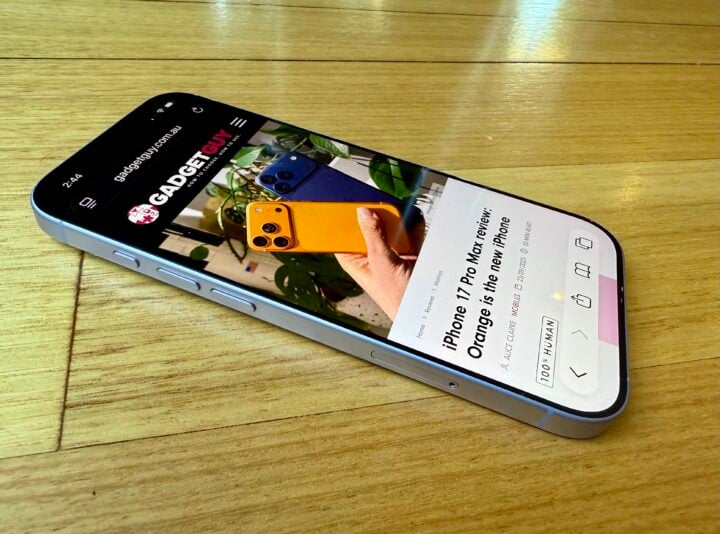
Compared instead to last year’s standard iPhone 16, this year’s standard iPhone 17 sports some impressive improvements. It steps up from a 6.1 to 6.3-inch display, while bumping up to 2622-by-1206-pixel resolution to maintain 460 pixel-per-inch sharpness.
As a result of the larger screen, it’s a tad taller, thicker and heavier than the iPhone 16, yet somehow a fraction thinner.
All of these changes bring the iPhone 17 practically into line with the Pro range, except that Pro models are a little thicker and heavier again, courtesy of their third rear telephoto lens.
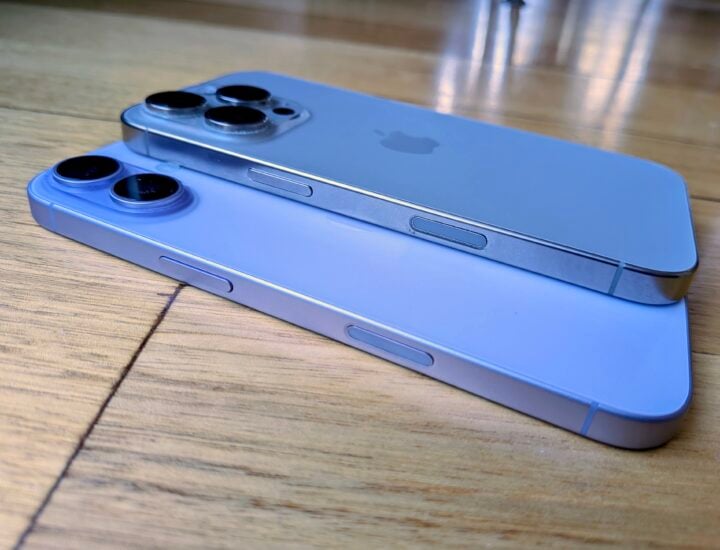
By dropping the same display into the iPhone 17 and iPhone 17 Pro, Apple has produced the first non-Pro iPhone to feature an always-on display and ProMotion technology with adaptive refresh rates up to 120 Hz.
Cameras aside, up until now, these high-end screen features are what have helped make the Pro line more appealing. Apple would never admit it, but pressure to improve the screen on the base model iPhone was growing when these features come standard in many mid-range Android handsets.
If you’re after an even larger display but without all the other bells and whistles of the Pro, you’ll be disappointed to hear that Apple hasn’t released an iPhone 17 Plus to follow on from the iPhone 16 Plus. It has, however, delivered a plus-sized iPhone 17 Pro Max, along with the super-slender iPhone Air 17.
Some improvements available with this standard iPhone 17 weren’t inherited from the Pro models, but are instead an upgrade for the entire new iPhone 17 line-up.
This year, the display on the entire iPhone 17 range steps up to 3000-nit brightness, so it’s easier to read in direct sunlight. The entire range also upgrades to Durable Ceramic Shield 2 glass on the front, which offers three-times better scratch resistance and feels a little different under your fingerprints compared to the first-generation Durable Ceramic Shield used on the iPhone 16 line-up.
The standard iPhone 17 retains the aluminium frame and colour‑infused glass back, while the iPhone 17 Pro switches from titanium to aluminium, adding a Durable Ceramic Shield glass back for extra ruggedness.
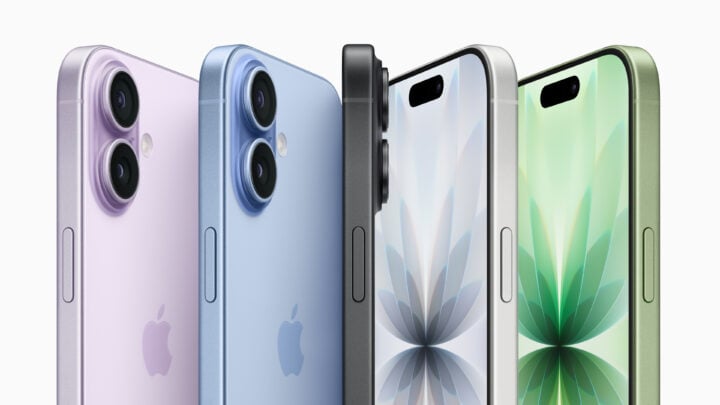
The handset delivers stereo sound in landscape mode by taking advantage of the earpiece as a second speaker. It goes surprisingly loud, but you shouldn’t push it past 70 per cent unless you particularly enjoy super-brash and distorted audio.
As you’d expect, the standard iPhone 17 also retains Apple’s Action and Camera Control buttons, which trickled down from the Pro range to the standard iPhone 16 models last year.
Look closely and you’ll notice that the SIM card slot on the left has changed – now lower and wider – because the SIM card slots sideways into the phone.
Most people will be pleased to see that Apple has retained support for physical SIM cards in Australia, as it moves some devices to eSIM-only (including US iPhones). When upgrading from an old iPhone, the iPhone 17’s setup process tries to convince you to transfer the details from your old physical SIM to the new phone’s eSIM (which received a hard pass from me).
Apple iPhone 17 specifications and price
| Display size | 6.3 inch, 19.5:9 aspect ratio |
| Display resolution | 2622×1206 pixel, 460 ppi |
| Display technology | OLED Super Retina XDR display Always-on 3,000 nits peak brightness ProMotion up to 120Hz HDR + Wide Colour P3 2,000,000:1 contrast ratio 1,000 nits max brightness (typical); 1,600 nits peak brightness (HDR); 3,000 nits peak brightness (outdoor); 1 nit minimum brightness |
| Bands | 5G (sub-6 GHz) with 4×4 MIMO Gigabit 4G LTE with 4×4 MIMO |
| CPU | Apple A196‑core CPU with 2 performance and 4 efficiency cores 16‑core Neural Engine Hardware-accelerated ray tracing |
| GPU | 5‑core GPU with Neural Accelerators |
| Rear cameras | 48MP Fusion Main: 26 mm, ƒ/1.6 aperture, sensor-shift optical image stabilisation, 100% Focus Pixels, support for super-high-resolution photos (24MP and 48MP). Also enables 12MP optical-quality 2x Telephoto: 52 mm, ƒ/1.6 aperture, sensor-shift optical image stabilisation, 100% Focus Pixels |
| Lavender, Sage, Mist Blue, White and Black | |
| Front camera | 18MP Center Stage: ƒ/1.9 aperture, Autofocus with Focus Pixels |
| RAM | 8 GB |
| Onboard storage | 256 or 512 GB |
| microSD slot | N/A |
| SIM | nanoSIM + eSIM (dual eSIM support) |
| Charging | USB-C 2.0 MagSafe wireless charging up to 25W Qi2 wireless charging up to 25W |
| Battery | Up to 27 hours video playback Up to 50% charge in 20 minutes with 40W adapter or higher (available separately) paired with USB‑C charging cable |
| Wi-Fi | Wi‑Fi 7 (802.11be) with 2×2 MIMO |
| Connectivity | Bluetooth 6.0 Thread Apple second-generation Ultra Wideband |
| Operating system | iOS 26 |
| Security | Face ID |
| Ruggedness | IP68 |
| Dimensions | 149.6 x 71.5 x 7.95 mm |
| Weight | 177 gm |
| Colours | Lavendar, Sage, Mist Blue, White and Black |
| Price | from $1,399 RRP |
| Warranty | 1 year |
| Official website | Apple Australia |
Features
Under the bonnet, the Apple iPhone 17 packs the new A19 chip, which is still blessed with a six-core CPU: two performance and 4 efficiency cores. The 5-core GPU now features Neural Accelerators to support Apple Intelligence.
The A19 powerplant is accompanied by 8 GB of RAM, whereas this year’s Pro models pack 12 GB. It is good to see that Apple has stepped up to 256 GB of storage in the entry-level $1,399 iPhone 17 model, which only bought you 128 GB this time last year.
Put to the test, all that Apple Silicon doesn’t disappoint, delivering Geekbench 6 results of 3,520 single-core, 9,057 multi-core and 37,161 GPU. That mostly outguns the old iPhone 16 Pro, which delivers 3,562, 8,862 and 33,052 running iOS 18 on an A18 Pro chip.
Dig around inside the iPhone 17, and you discover all of the onboard chips and sensors remain the same, except for the upgrade to Bluetooth 6.0 and Precision dual-frequency GPS, the latter of which is also coming to Android devices like the Google Pixel Watch 4.
The battery life also gets a boost, with roughly a 30 per cent jump in terms of video playback time to 30 hours. You also benefit from faster charging, delivering a 50 per cent charge in 20 minutes if using a 40W AC adapter. Make that 30 minutes for a 30W AC adapter or a MagSafe Charger. As usual, there’s no charger in the box, only a USB-C to USB-C cable.
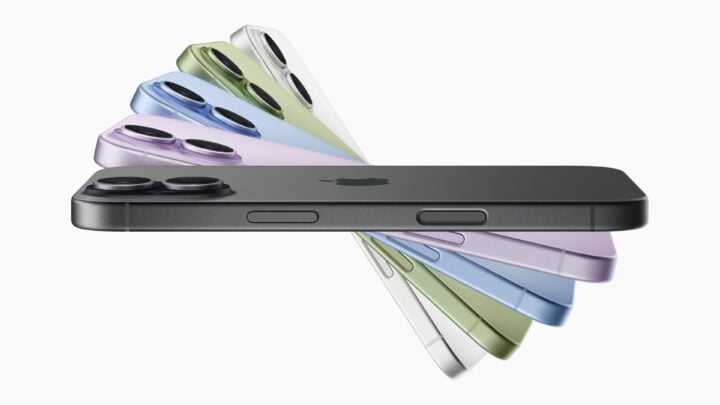
The new hardware is accompanied by the launch of iOS 26, making the leap from iOS 18 to get all of Apple’s devices on the same number OS. It comes with the promise of at least five years of software updates. That’s very good, but not as impressive as some Android handsets, which stretch it to seven years.
With iOS 26 comes the bubbly and translucent “Liquid Glass” look and feel. It’s certainly an acquired taste and feels to me like a distracting step backwards.
It impacts every aspect of the UI, right down to the look of the desktop icons, which have a little more depth, but to me, it’s all too cutesy and child-like, without actually enhancing the user experience. Everything also looks a little washed out, with pure whites looking a little soft and creamy.
Many design elements wobble and pulsate for no good reason, like it’s aimed at toddlers enthralled by shiny things. Liquid Glass is coming to practically all Apple devices; I can already see it on the Apple Watch, and I’m dreading the day it comes to macOS (here endeth the old man rant).
It seems that Liquid Glass was toned down a bit after WWDC 2025 demos, and it will be interesting to see if Apple tones it down more in the long run, similar to the way Microsoft toned down Windows Aero back in the day.
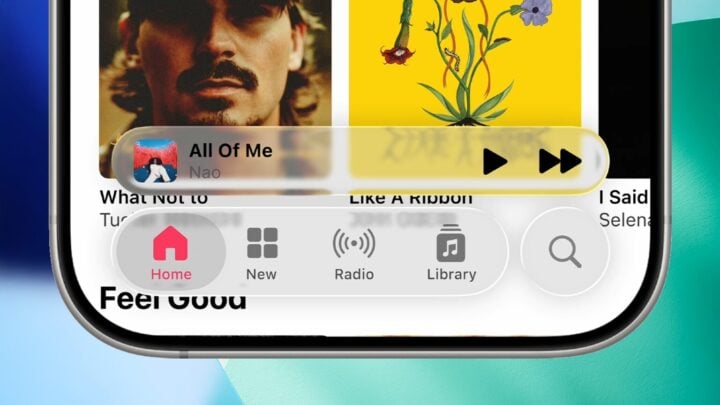
Without diving into all the fine details, iOS 26 highlights include Call Screening for unknown callers and Hold Assist, which listens in while you’re on hold and alerts you when the person on the other end comes back to the call.
Apple Intelligence also gains a few extra features, including Live Translations and improved Visual Intelligence when searching with your camera.
Photography features
In terms of hardware, apart from the display, the biggest improvements on the standard iPhone 17 are reserved for the cameras, once again straying into Pro territory.
Instead of the iPhone 16’s “Advanced dual-camera system”, which combines a rear 48MP Fusion Main and 12MP Ultra Wide, the iPhone 17 sports a “Dual Fusion camera system” combining a 48MP Fusion Main and 48MP Fusion Ultra Wide.
Once again, that brings the iPhone 17 into line with the Pro range, except that you miss out on the Pro’s third dedicated telephoto lens. This means you get .5x, 1x and 2x optical zoom options but miss out on 4x and 8x.
As part of iOS 26, the new camera app interface is stripped back, with more features hidden away in menus, which will frustrate some people.
Put to the test, the iPhone 17 delivers impressive photos which are on par with the iPhone 16 Pro in terms of vividness, detail and low light performance. Upgrading from the 12 MP ultrawide sensor in the iPhone 16 to the 48 MP ultrawide from the Pro ensures that it doesn’t dial back the detail when you switch to the ultrawide view.




New with the entire iPhone 17 range is Dual Capture, recording video from the front and rear cameras simultaneously at up to 4K Dolby Vision at 30 fps. (To be fair, this is old hat in Android world).
Once in video mode, Dual Capture is easy to launch from the six-dot menu icon at the top right of the screen. The view from the front camera appears picture-in-picture, and you can drag it around the screen while recording, as well as zoom in and out on the view from the rear camera.
Dual Capture is a handy and intuitive feature that video content creators are likely to quickly embrace, plus it lets videographers drop themselves into home videos rather than always hiding behind the camera.
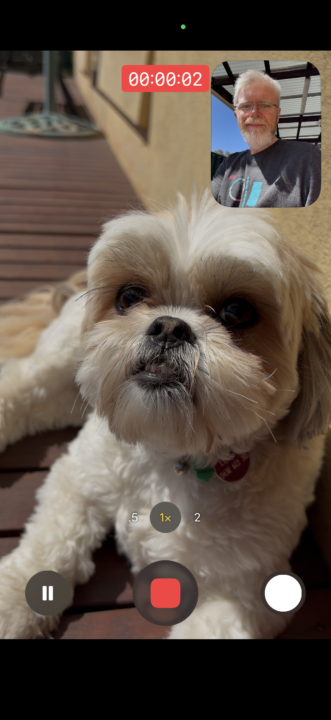
Surprisingly, you can’t flip things around, so the view from the rear camera is picture-in-picture. Nor can you use it when taking still photos.
Thanks to the new 18 MP “Centre Stage” front camera, the entire iPhone 17 range can automatically zoom, pan and change the aspect ratio to keep you centred during video calls, as well as automatically adjust the frame when taking group selfies or videos. The new front camera also adds support for ultra-stabilised video.
Who is the Apple iPhone 17 for?
Of this year’s new Standard, Air, Pro and Pro Max iPhones, this Standard iPhone 17 is certainly the pick of the bunch when it comes to value for money, encroaching further and further into Pro territory while retaining the base model price tag.
Rather than the Pro versions tempting people to step up, I’d argue that the Apple iPhone 17 will tempt people to step down from a Pro model.
Current Pro owners who are ready to upgrade but currently tight on cash will have to seriously consider whether they make enough of the Pro’s remaining extra features like the telephoto lens, ProRAW support and larger battery to justify the extra expense.
GadgetGuy occasionally uses affiliate links and may receive a small commission from purchased products.
